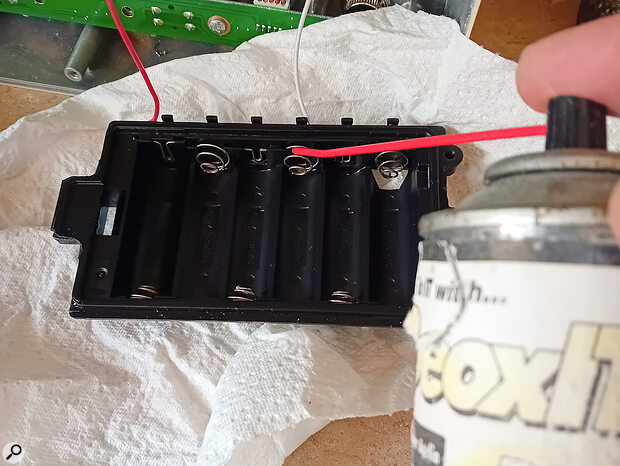 A bad case of ‘the crusties’ on a delay pedal that doesn’t see enough use!
A bad case of ‘the crusties’ on a delay pedal that doesn’t see enough use!
I’ve had this a few of times now! I’ve forgotten to remove the batteries I put in some gear — a couple of stompboxes, an Ebow — and then, out of sight, out of mind, I left them like that for a couple of years. And of course, when I go to use them again, it turns out that the batteries have leaked all over the battery compartment and on replacing the batteries and scratching away the ‘crust’ on the contacts, the gear still doesn’t work. I assume I need to do a better job of cleaning away all that detritus, but is there a ‘right’ way to do it?
Marc Williams
SOS Reviews Editor Matt Houghton replies: Yeah, we’ve all been there at one time or... many others! Our Technical Editor might well tut, as I know he’s rather more careful and organised with his gear than I am with mine, but I’ve had this happen with pedals, handheld recorders, my Ebow and even a mic. But thankfully I haven’t yet discovered anything I couldn’t bring back from the dead. As you say, the key is cleaning.
Bathe the compartment in something acidic to neutralise the leak and to dissolve all the ‘crud’. I use distilled white vinegar...
First, you need to remove the offending batteries, and wipe/scrape away any goo and loose dust left over from the leak. Then dispose of the batteries safely. (Just in case, don’t do any of this with bare fingers!) As for cleaning the gear, the specifics are going to depend somewhat on what the gear is and the access you have to the battery compartment. But ideally you want to bathe the compartment in something acidic to neutralise the leak and to dissolve all the ‘crud’. I use a weak (circa 6%) distilled white vinegar solution for this, which is very affordable and doesn’t leave behind any nasty residue.
 Removing the battery compartment and soaking it in distilled white vinegar removed most of the gunk that had leaked out of the batteries.
Removing the battery compartment and soaking it in distilled white vinegar removed most of the gunk that had leaked out of the batteries.
The vinegar will do most of the work, but you might find on some stubborn areas you need to mechanically scrape or rub the last bits away. And if the practicalities of the device mean you can’t actually bathe it, then you can apply it with cotton wool and rub it in. With a bad leak, the damage may extend beyond the compartment itself, so check for that — use the same method to address that, though note that if the batteries leaked onto any components or PCB it may well be unsalvageable.
 A final dry, scrape, and squirt of contact cleaner finishes the job.
A final dry, scrape, and squirt of contact cleaner finishes the job.
When done, rinse and dry the area (I use kitchen towel for this). Then you just need to make sure the battery contacts are clean enough to make a good contact. Again, you can just give these a good scrape or rub with something abrasive and blow away any dust, and then, for good measure, give them a squirt of contact cleaner such as DeOxit D5 or Kontakt Super 10. That should be job done: stick some new batteries in there and give your gear a try. If that hasn’t done the trick, it’s time to let go, buy a replacement, or if the gear’s rare or valuable maybe contact an electronics repair specialist.
